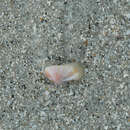en
names in breadcrumbs


Other common names for Donax variabilis include bean clam, butterfly clam, donax clam, and southern coquina.
There is no known social communication between coquinas. However, they have a tendency to live within close proximity of each other, most likely due to favorable environmental factors for the clams.
Perception Channels: tactile ; chemical
Coquinas are not listed in the IUCN, as they are very common along beaches in the eastern United States. However, coquinas face certain challenges, such as rising sea levels, global warming, and beach erosion. Laws and regulations that curtail erosion and maintain the natural flow of sand on beaches benefit populations of this clam.
US Federal List: no special status
CITES: no special status
State of Michigan List: no special status
Coquina clams undergo indirect development, first from a trochophore larva to a veliger larva. The veliger larva uses its ciliated velum for swimming and feeding on plankton. Eventually, the veliger will settle to the seafloor, where it undergoes metamorphosis to the adult stage.
Development - Life Cycle: metamorphosis
Through their filter-feeding, coquinas can concentrate toxins and harmful organisms (bacteria, viruses, etc) that may cause harm to humans when eaten.
Negative Impacts: injures humans (causes disease in humans , carries human disease, poisonous )
Coquinas are eaten and used as decoration because of their colorful markings. The shells are also be used in ornamental landscaping.
Positive Impacts: food ; body parts are source of valuable material
Coquinas serve as food sources for shorebirds, fish, and humans. In addition, the abundance of coquinas on beaches is an indicator of the beach habitat’s ability to sustain life. A beach with a large number of coquinas indicates a healthy beach habitat due to the presence of naturally-formed sand and the absence of external factors such as human construction.
Coquinas are filter feeders, feeding primarily on phytoplankton, algae, detritus, bacteria, and other small particles suspended in the surf as the waves ebb and flow. Feeding is performed through the use of short siphons.
Plant Foods: algae; phytoplankton
Other Foods: detritus ; microbes
Foraging Behavior: filter-feeding
Primary Diet: planktivore ; detritivore
The coquina clam, Donax variabilis, ranges from the eastern coast of the United States, from New York to the Caribbean, and across the Gulf of Mexico and into Texas.
Biogeographic Regions: nearctic (Native ); atlantic ocean (Native )
Coquina clams are commonly found at sandy beach fronts in the intertidal zone, where the tides ebb and flow. Some can also be found in knee-deep waters.
Habitat Regions: saltwater or marine
Aquatic Biomes: coastal
Other Habitat Features: intertidal or littoral
Coquinas typically live between 1 to 2 years in the wild but can only live up to 3 days in the absence of moving water. Lack of water deprives the coquina of nutrients obtained through filter feeding.
Typical lifespan
Status: wild: 2 (high) years.
Coquinas have small, long, triangular-shaped shells, ranging from 15 to 25 cm in length. These shells contain very colorful bands, with a range of colors anywhere from red to violet.
Range length: 15 to 25 mm.
Other Physical Features: ectothermic ; bilateral symmetry
Sexual Dimorphism: sexes alike
Coquinas are consumed by various fish (such as Trachinotus carolinus and Menticirrhus spp.), shore birds, and humans (Homo sapiens).
Known Predators:
Coquinas typically live in close proximity of each other, sometimes in colonies. They release their gametes when gravid and their close proximity with each other heightens the chances of fertilization.
Coquina clams are dioecious (male and female) broadcast spawners. Eggs and sperm are released synchronously into the water for external fertilization.
Breeding interval: Gametes are released when gravid
Key Reproductive Features: gonochoric/gonochoristic/dioecious (sexes separate); sexual ; fertilization (External ); broadcast (group) spawning; oviparous
There is no form of parental care. Fertilization occurs externally and larvae are left to feed and swim independently.
Parental Investment: no parental involvement